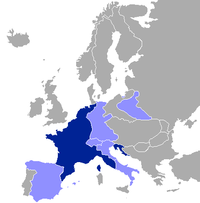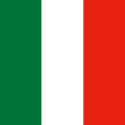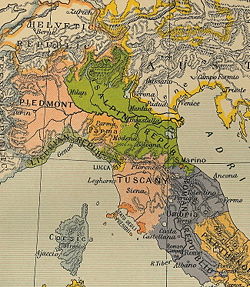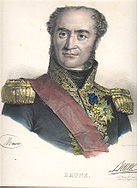- Cisalpine Republic
-
Cisalpine Republic
Repubblica CisalpinaPuppet state of the First French Republic ← 
←
←
←
1797–1802  →
→The flag of the Cisalpine Republic was the Transpadane vertical Italian tricolour, with the square shape of the Cispadane flag.
The Cisalpine Republic (green) in 1799. Capital Milan Language(s) Italian Government Directorial Republic Directory - 1797–98 First Directory - 1798–99 Second Directory Legislature Legislative Council - Upper house Council of Elders - Lower house Council of Juniors Historical era Napoleonic Wars - Decree of Napoleon Bonaparte June 29, 1797 - Treaty of Campo Formio October 17, 1797 - Occupied by Austria April 27, 1799 - Restored by France June 2, 1800 - Renamed Italian Republic January 26, 1802 Currency Milanese scudo, lira, soldo and denaro The Cisalpine Republic (Italian: Repubblica Cisalpina) was a French client republic in Northern Italy that lasted from 1797 to 1802.
Contents
Birth
After the Battle of Lodi in May 1796, Napoleon Bonaparte proceeded to organize two states: one to the south of the Po River, the Cispadane Republic, and one to the north, the Transpadane Republic. On May 19, 1797, Napoleon transferred the territories of the former Duchy of Modena to Transpadania and, on Messidor 12 (June 29), he decreed the birth of the Cisalpine Republic, creating a Directory for the republic and appointing its ministers. France published the constitution of the new republic on Messidor 20 (July 7), establishing the division of the territory into eleven departments: Adda (Lodi), Alpi Apuane (Massa), Crostolo (Reggio), Lario (Como), Montagna (Lecco), Olona (Milan), Panaro (Modena), Po (Cremona), Serio (Bergamo), Ticino (Pavia), and Verbano (Varese).
The rest of Cispadania was merged into the Cisalpine Republic on July 27, with the capital of the unified state being Milan. On Brumaire 1 (October 22) Bonaparte announced the union of Valtelline with the republic, after its secession from the Swiss Three Grey Leagues. Austria acknowledged the new entity in the Treaty of Campoformio of October 17, gaining in exchange what remained of the Venetian Republic. On Brumaire 25 (November 15) the full international recognition and legality of the new state was ratified by the law governing the final annexation of the conquered territories.
The parliament, composed of two chambers (the Great Council and the Council of the Seniors), was appointed directly by Napoleon on Frimaire 1 (November 21). He justified this undemocratic action as a necessity of war. New departments joined the 11 original ones and Valtelline in the following months: Benaco (Desenzano) on Ventose 11 (March 1, 1798), Mella (Brescia) on Floreal 13 (May 2), Mincio (Mantua) on Prairial 7 (May 26), and five departments of Emilia. The structural phase of the republic was terminated on Fructidor 14 (August 31), when France dismissed all the authorities of the republic, replacing them by a stronger executive power under a new constitution.
Institutional form
The Cisalpine Republic was for many years under the domination of the Empire of Austria.
The French Republic acquired it by right of conquest. She renounces dominion over it on this day, and the Cisalpine Republic is now free and independent. Recognized by France and by the Emperor, as it will soon be likewise by all of Europe.
The Executive Directory of the French Republic, not content with having expended its influence and the victories of the republican armies to ensure the political existence of the Cisalpine Republic, pushes more faraway its promptnesses; and being convinced that, if liberty is first among all good things, a revolution leaves behind itself the worst of all scourges, now gives to the Cisalpine people its Constitution, which is the result of the knowledge of the most enlightened nation.
From a military regime, the Cisalpine people must therefore pass to a constitutional regime.
In order that this passage shall be effected without disruption, without anarchy, the Executive Directory has decided only this once to appoint the members of the government and of the legislative branch, so that the people shall not, until one year, appoint officials to fill vacant offices according to the Constitution.
In reality, no republics have existed in Italy for many years. The holy fire of liberty was stifled, and the most beautiful part of Europe lived under the yoke of foreigners. It is up to the Cisalpine Republic to show to the world with its wisdom and energy, and with the good organization of its armies, that modern Italy has not degenerated, and that it is still worthy of freedom.
Signed, Bonaparte.—Preamble to the Constitution of the Cisalpine Republic, Messidor 20, year V (July 7, 1797).The institutions of the new republic were very similar to those of France. The territory was divided into departments which elected the judges of peace, the magistrates and the electors, one for every 200 people having the right to vote. The latter elected two councils: the Consiglio dei Seniori ("Council of the Seniors") and the Gran Consiglio ("Great Council"). The first was initially composed of 40 to 60 members and approved the laws and modifications to the Constitutional Chart. The second initially had from 80 to 120 members and proposed the laws. Both councils discussed treaties, the choice of a Directory, and the determination of tributes. The legislative corps included men like Pietro Verri, Giuseppe Parini and the scientist Alessandro Volta. The electors had to be landowners or wealthy.
The Directory was composed of five directors and represented the executive power: leaders were local politicians like Gian Galeazzo Serbelloni, the first president. The Directory chose its secretary, and appointed the six ministers: for justice, war, foreign affairs, internal affairs, police, and finance. The supreme authority, however, was the commander of the French troops. The republic also adopted the French Republican Calendar.
Each department had its own local directory of five members, as did communes between 3,000 and 100,000 inhabitants. The biggest communes were divided into municipalities, with a central joint commission to handle the general affairs of the cities. The smallest communes were united in districts with a single municipality, with each commune having its own municipal agent.
Second constitution
The first constitution did not have a long life. On Fructidor 14, year VI (August 31, 1798), the French ambassador Claude-Joseph Trouvé (who was only thirty years old) dismissed the Directory, and the next day he promulgated a new constitution with a stronger executive power.
The departments numbered eleven again, now covering larger geographical areas: Olona (Milan), Alto Po (Cremona), Serio (Bergamo), Adda and Oglio (Morbegno), Mella (Brescia), Mincio[1] (Mantua), Panaro (Modena), Crostolo (Reggio), Reno (Bologna), Basso Po (Ferrara), Rubicone (Forlì). The membership of the local directories was reduced to three, and the municipalities for communes between 3,000 and 10,000 inhabitants were disbanded.
Trouvé appointed the new Directory, which had stronger powers, and a new parliament composed of two councils: the Anziani ("Elders") and the Giuniori ("Youngers"). The first was composed of 40 elected members together with the former directors. The second had 80 members.
A new coup d'état, attempted by French general Guillaume Marie Anne Brune the next autumn, was disavowed by the French Directory on Frimaire 17 (December 7).
Directors
The first Directory of the republic was appointed by Napoleon the same day as the proclamation of the birth of the State, on Messidor 12, year V (June 29, 1797).
- Giovanni Galeazzo Serbelloni (resigned)
- Marco Alessandri
- Giovanni Costabili
- Pietro Moscati (resigned)
- Giovanni Paradisi (resigned)
- Giovanni Battista Savoldi (substituted for Serbelloni from November 23, 1797)
- Jacopo Lamberti (substituted for Moscati from April 16, 1798)
- Carlo Testi (substituted for Paradisi from April 16, 1798)
The second Directory of the Republic was appointed by Trouvé the same day as the proclamation of the second constitution, on Fructidor 14, year VI (August 31, 1798).
- Girolamo Adelasio (dismissed by General Brune on October 17, restored by France on December 14)
- Marco Alessandri (2nd term) (resigned)
- Jacopo Lamberti (2nd term)
- Giuseppe Luosi (dismissed by General Brune on October 17, restored by France on December 14)
- Fedele Sopransi (dismissed by General Brune on October 17, restored by France on December 14)
- Antonio Sabbati (under Brune's nomination from October 17 to December 14)
- Antonio Smancini (under Brune's nomination from October 17 to December 14)
- Vincenzo Brunetti (under Brune's nomination from October 17 to December 14)
- Ferdinando Marescalchi (substituted for Alessandri from March 20, 1799)
- Fedele Vertemate Franchi
On Germinal 21, year VII (April 10, 1799) the Directory received special powers to meet the Austrian and Russian invasions after the formation of the Second Coalition. The next day, a Military Committee, a Finance Committee and a Public Health Committee were established. On Floreal 7 (April 26) an order was given to evacuate the Legislative Council. On April 29, 1799, Austrian rule was restored and the Directory abolished.
The treaty of alliance
Formally, the Cisalpine Republic was an independent state allied with France, but the treaty of alliance established the effective subalternity of the new republic to France. The French in fact had control over the local police, and left an army consisting of 25,000 Frenchmen, financed by the republic. The Cisalpines also to form another army of 35,000 of their own men to take part in French campaigns.
On March 4, 1798, the Directory presented this treaty to the Great Council for ratification. The council did not agree with the terms, and delayed taking a decision, but in the end the French general Berthier compelled acceptance by the members. The Seniors however refused it from the very beginning, as the new state was unable to finance the requested institutions. Berthier threatened to impose a military government, but was later replaced by general Brune. The latter, after replacing some Seniors and Juniors, achieved the signing of the treaty on June 8.
Relations with Switzerland
The new government aimed to unite all Italian lands into a single state. This fact created tensions with Switzerland, which included Italian-speaking areas south of the Alps. On October 10, 1797, the French supported a revolt in Valtelline. The Cisalpine Republic ended up taking control of Campione d'Italia and the Valtellina from Grisons and joined the republic. A Cisalpine attempt to conquer Lugano by surprise failed in 1797.
The second republic
The republic was dissolved after the defeat of France by the Second Coalition in April 1799. It was occupied by General Suvurov's Russian and Austrian forces, which appointed a provisional administration led by the Imperial Commission of the Mantuan Count Luigi Cocastelli. They departed only on May 30, 1800, just few days before Napoleon won the Battle of Marengo.
The Cisalpine Republic was restored by Napoleon on Prairial 15, year VIII (June 4, 1800). On Prairial 28 (June 17) the First Consul appointed an Extraordinary Commission of Government of nine members, and a legislative Consulta: the final list of the executive and legislative institutions was published on Messidor 5 (June 24). On Messidor 16 (July 6) all the acts issued during the Austrian occupation were annulled, and afterwards the tricolour flag was restored.
Napoleon's new victories gave him the possibility to stabilize the political situation in all of northern Italy. On Vendemiaire 3, year IX (September 25), the powers of the Extraordinary Commission were concentrated in the hands of a more restricted Committee of Government, composed of three members: Giovan Battista Sommariva, Sigismondo Ruga and Francesco Visconti, reflecting the institution of the French Consulate. On Vendemiaire 21 (October 13), owing to the refusal of the escaped King Charles Emmanuel IV of Savoy to sign a treaty of peace settling the situation of the occupied Piedmont, Napoleon ordered the annexation of Novara to the republic, shifting its western border from Ticino to the Sesia River. After the surrender of Austria and the signing of the Treaty of Lunéville on February 9, 1801, the territory of the republic was extended on the eastern side as well, placing the frontier with the Holy Roman Empire on the Adige River without the exceptions agreed in Campo Formio. On Floreal 23 (May 13), the territory of the republic was divided into 12 departments, adding Agogna (Novara), restoring Lario and abolishing Adda-e-Oglio.
 The Consulta of the République cisalpine receives the First Consul on 26 January 1802, Nicolas-André Monsiau, 1806–08
The Consulta of the République cisalpine receives the First Consul on 26 January 1802, Nicolas-André Monsiau, 1806–08
On Brumaire 21, year X (November 12) an Extraordinary Cisalpine Consulta was summoned in Lyon. In January 1802, the Consulta decided to change the name of the State to the Italian Republic, when Napoleon had himself elected president, on January 24, on the advice of Talleyrand. Two days later, in a scene officially commemorated by Monsiau, Bonaparte appeared in the Collège de la Trinité of Lyon, attended by Murat, Berthier, Louis Bonaparte, Hortense and Joséphine de Beauharnais, and heard the assembled notables proclaim the Italian Republic. On Pluviose 21 (February 10) the new constitutional government was proclaimed in Milan by Sommariva and Ruga. The same day, the Gregorian calendar was restored.
Sources
Notes
- ^ The Constitution was written so fast that the department of Mincio was erroneously listed as Milano.
See also
- French client republic
- Cisalpine Gaul
- Italian Republic
Client states of the French Revolutionary and Napoleonic Wars (1792–1815) French client
republics- Bologna
- Cisalpinia
- Cispadania
- Italian Republic
- Liguria
- Lucca
- Parthenopea
- Rome
- Transpadania

Europe at the height of Napoleon's Empire Other
Napoleonic
creations- Etruria
- Lucca and Piombino
- Kingdom of Italy
- Naples
Categories:- Former countries on the Italian Peninsula
- Former client states
- States and territories established in 1797
- States and territories disestablished in 1802
- 1802 disestablishments
- Risorgimento
Wikimedia Foundation. 2010.




